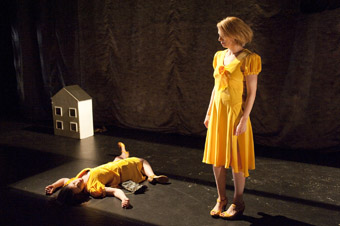murder reverie
jonathan bollen: ladykillers, the pyjama girl

Jo Stone, Astrid Pill, The Pyjama Girl, Ladykillers
photo Shane Reid
Jo Stone, Astrid Pill, The Pyjama Girl, Ladykillers
IN REMEMBRANCE OF THE DEAD—THIS IS ONE OF THE MORE ENDURING FUNCTIONS OF PERFORMANCE: TO CONJURE THE SPIRITS OF THE PAST, TO LURE GHOSTS FROM THEIR GRAVES, TO EXHUME THE LIVES OF THOSE WHO HAVE DISAPPEARED.
Written histories and documentaries do much the same thing, but the rigours of authentication and realism often extinguish the warmth, intimacy and affection that performance can evoke.
The Ladykillers’ new work is an evocation. It calls forth the mystery of a murdered woman—the Pyjama Girl—whose body, dressed in yellow silk pyjamas, was found in a roadside culvert in Albury, New South Wales, in 1934. The woman was not identified until 1944, and then perhaps incorrectly, when a man confessed to the murder of his wife. The body was buried and the man convicted. But the case has been revisited several times since.
Historian Richard Evans’ 2004 book, for instance, casts considerable doubt on the identification and conviction, and raises questions about the conduct of the then New South Wales Commissioner of Police. The Ladykillers’ production does not seek to set the record straight. What it does, initially, is evoke an historical aesthetic that distances the trauma of the case, setting its eroticism and violence in the past.
The Australian 1930s are conjured with design (Gaelle Mellis), music and sound (Zoë Barry, Jed Palmer): a bakelite radio and an old-style microphone, a man’s hat and the women’s shoes, the instrumentation of popular song and the clipped accent of a newsreel announcer. At the outset, performer Stephen Sheehan, seated in a cane armchair, reading the evening news, projects a relaxed image of masculine order. Chaos may be consumed as evening entertainment for, in his work today, he has ensured that public order prevails in the world.
Not so within the fevered inner world of the women in the work. Performers Astrid Pill and Jo Stone, a blonde and a brunette, dressed in yellow frocks and high-heeled yellow shoes, play around a doll’s house and whisper to each other. Later, furtively, at home alone, Pill stuffs biscuits in her mouth and washes down the crumbs with swigs from a hip flask. The women perform the emotions of disquiet. They are often anxious and ill-at-ease. They take turns in dancing with the man—or, rather, listlessly being danced by him.
Vocally, the women are erotically assertive, anachronistically articulate. “Come on, punch me. Hit me. Give me a black eye”: one attempts to arouse the man with erotic fantasies of domestic violence—but fails. Instead, they play dress-ups to jazz percussion, swapping gender roles with shoes and hats. The man croons a song of love forgotten: “My old flame, I can’t even think of her name.” A woman censors her sexuality, infantilising herself by intoning quietly: “I am a bad girl. I am a bad girl.” The man tells a string of misogynistic jokes.
These gendered memories from the past are played skittishly like vignettes. But they also become painful and unpleasant. The violence, at times, feels real. Director Ingrid Voorendt choreographs the action with repetition to estrange the impact of bad affects. In the program notes, she asks, “How do we deal with our fear of bad men?” and “How do good men deal with this?” Voorendt’s direction takes particular care not to disconnect its audience from these gendered questions.
Characters are dislodged as they form. For Pill and Stone, the doubling keeps the identity of the Pyjama Girl unsettled and dispersed throughout the work. With Sheehan, the tendency for suspicion and accusation to alight on him is explicitly rejected. As the work’s tensions are threatening to snap, Sheehan takes a break. Taking off his tie, he turns to the audience and addresses us directly: “I’m not him,” he reassures us. “The whole thing makes me sick.”
The work’s dramaturgy hinges on a transition from fantasy to reality. First up, fantasies about gender, violence, sex and death range freely across the story of the Pyjama Girl, activating a sensual historicity and some playful, role-reversing erotics. What follows then is, literally, reality as revelation. Surface elevation gives way to depth and fantasies hit the dirt. A knife is drawn, a voice floats free, and the body lies inert—but not alone.
If I were a woman with a male partner, I would take him to The Pyjama Girl and I think he would enjoy it. Like a funeral, it is both confronting and consoling. We would come home, make love and talk about it after.
Ladykillers, The Pyjama Girl, director Ingrid Voorendt, devisor, performer Astrid Pill, performers Jo Stone, Stephen Sheehan, devisors, composers, musicians Zoë Barry, Jed Palmer, designer Gaelle Mellis, lighting David Gadsden; presented by Vitalstatistix with Adelaide Festival Centre’s inSpace program, The Space, Adelaide Festival Centre, Dec 9-19
RealTime issue #95 Feb-March 2010 pg. 44






